Interview
This interview is taken from
AWN website site
Caroline Leaf: A Serious Game
BySharon Katz| Wednesday, December 15, 2010 at 7:40pm
Several years ago I’d heard that Caroline Leaf had moved on from filmmaking and was now painting. I was curious to know what was behind the shift, and even more curious to see her current work. I finally had an opportunity to interview her.
This October, at the Ottawa International Animation Festival, I finally had an opportunity to meet Caroline Leaf in person. Her films were among the first animated shorts I fell in love with when I discovered animation. The Street and The Owl Who Married A Goose to name just two of her many films, are among my favourites even to this day.
Several years ago I had heard that she had moved on from filmmaking and was now painting. I was curious to know what was behind the shift, and even more curious to see her current work.
I met with her over dinner one evening, and we continued our conversation by email after she returned to London.
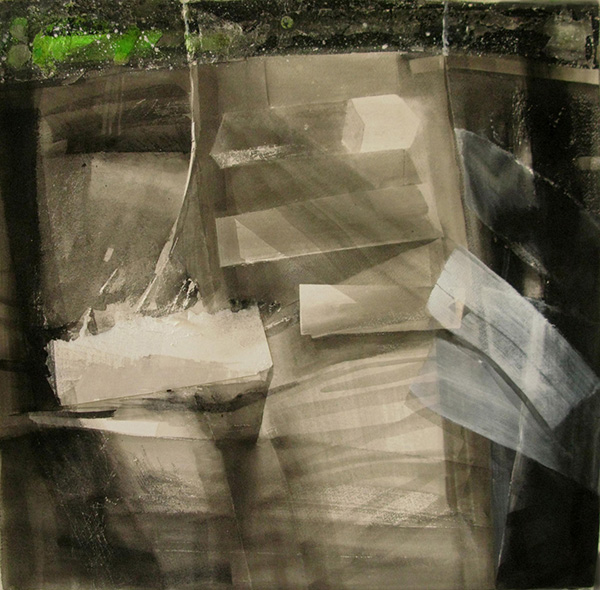
DF's Garden by Caroline Leaf
(ink, acrylic, gouache on paper, 22 x 22 in.)
Courtesy of the artist. |
sk: Clearly you are enjoying creating still images. Your pleasure is palpable in the work. How does the process differ for you from working in animation, and what aspects of it do you find most satisfying?
cl: The processes of making still images and making images that move are not all that different. Both are hard work and require concentration. For both, I am disciplined by the goal of making a total work. That is, even as I enjoy surprising myself with details in the composition, I am thinking about serving the needs of the whole image or of the whole film story. You wouldn't think this is an issue, but improvisation easily gets off track from the main goal. For me, making still images and making moving images are improvisations. The end results look spontaneous, though the under-the-camera straight ahead animation is somewhat preplanned and the still images are often reworked alot. What is most satisfying about making still images is that they are more spontaneous than the animation: I surprise myself with every mark on the paper or canvas. I've learned how to use chance. The still images are finished in days and I'm on to another idea. I'm not sitting on a stool in a dark room. I'm in sunshine in Australia or London or wherever, and I'm dancing, coming close, going far way, turning the picture upside down, putting it on the floor. I feel lively when I paint.
sk: You speak about allowing improvisation in your work, but keeping it from moving you too far off track from the main goal. What would you say is the primary goal of your work? You don't strike me as an artist who is manipulating formal elements, or one whose primary focus is concept. Is it then to tell a story, or communicate a visual impression that you've experienced?
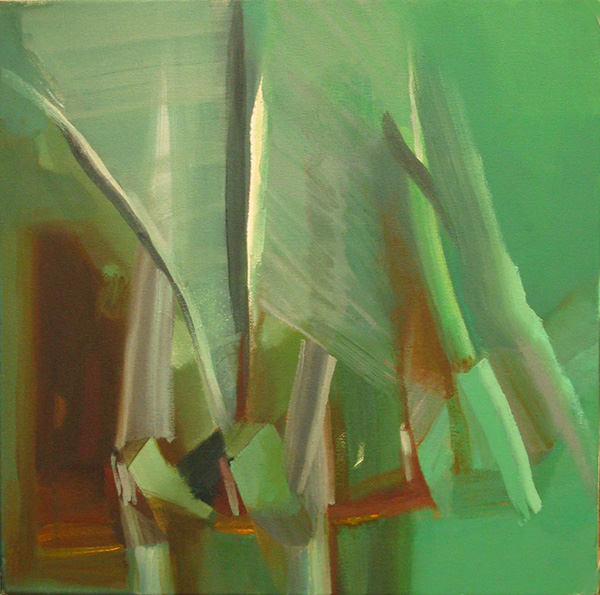
24 June 2010 by Caroline Leaf
(oil on canvas, 24 x 24 in.)
Courtesy of the artist. |
cl: The primary personal goal of my work is to make friends and be liked. To achieve that I need to make a work that is understood. I would like to make my contact with viewers via emotion as much as via intellectual contact. To be understood, my work needs to be coherent. So the main working goal is coherence.
When I am making my films, I am primarily a storyteller. Everything must serve the story. With the still images, everything must add up to a coherent space.
sk: What would make a painting incoherent?
cl: When a work of my art is incoherent, people wrinkle their noses and don't get it. It's not that they don't like it. I think it's when the image isn't clear because the spaces aren't clear in relation to each other. Is this space in front of or behind another space. Every edge of every shape needs to know what it's doing. Then the image is coherent and viewers can decide if they like it or not.
What's interesting is that coherence and ambiguity co-exist. My still images are ambiguous. People see different things in them and that's fine with me. They're adding their bit and feel stimulated. I don't like a viewer to be puzzled because my intention isn't clear, because then there's a block in the communication. I think there's less ambiguity when I'm storytelling a film.
sk: Would you agree that in your paintings the audience reads depth in the layers and in the your films the audience watches the imagery unfold over time?
cl: Yes, I agree. I sure hope so. Are you comparing or connecting the depth and the time?
sk: Yes, I'm wondering if you're saying similar things but using different languages?
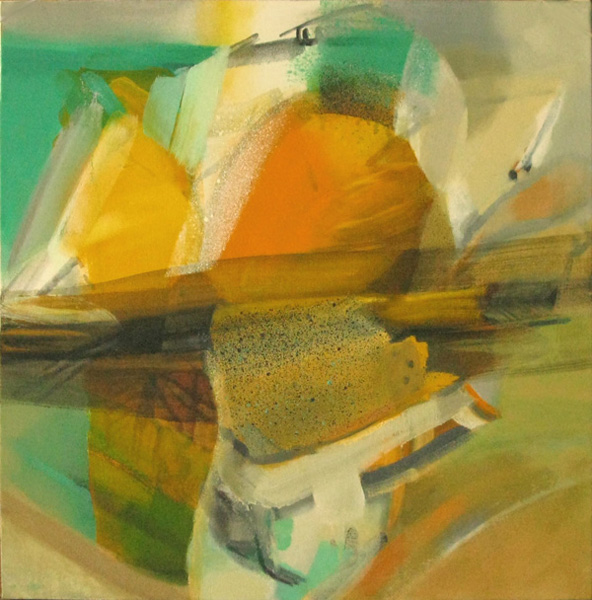
15 May 2010 by Caroline Leaf
(oil on canvas, 24 x 24 in.)
Courtesy of the artist. |
cl: In my films, you can say poetically that the audience sees the imagery unfold over time, but the imagery represents things...a head, a dress, a staircase. I think the audience sees a recognizable object moving through space. This is because the audience is oriented to the story.
I think moving images and still images are very different because time is involved differently in viewing them. Moving images require memory to comprehend, while a still image can be absorbed in it's entirety at one moment or over as much time as one wishes to look.
sk: What's at the source of these paintings for you? What drives you to pick up a brush? Do you have an image in mind first, or is it more about the sensuous play of colour and transparency that attracts you?
cl: Sometimes the work starts without any plan and I would almost call it a doodle as it begins. Then the doodle starts to look like something that can become a valuable composition when worked on with light and depth and color considerations. August 2010 [see below] started like this. Just as often though, the work starts with the memory of an image or feeling I want to capture. DF's Garden is an attempt to recall muggy Boston August heat in a friend's overgrown back yard. My earliest drawings always came from something I had seen and wanted to record, and were like diary entries.
I would say that the play of colour and transparency are tools that I have evolved because they attract me. Someone else would have other tools.
I pick up the brush to start a serious game with myself, and the process is hard and fun.
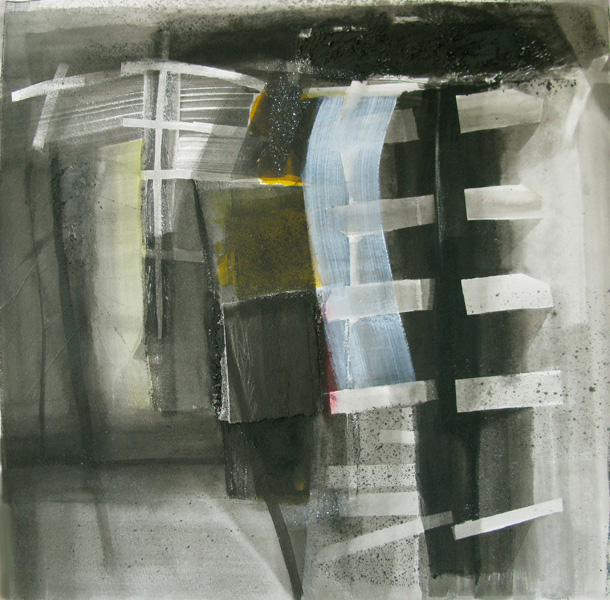
August 2010 by Caroline Leaf
(ink on paper, 14 x 14 in.)
Courtesy of the artist. |
sk: Do you ever draw or paint what's directly in front of you? Or do you always work from your imagination?
cl: I do alot of drawing from life, usually working with pencil or ink. I do my face when I can't think of anything else, or friends, or whatever is around the house. I consider them sketches.
sk: Tell me a little about them. What interests you most in the model? Representing what you see, the elements of light, shade, composition, story?
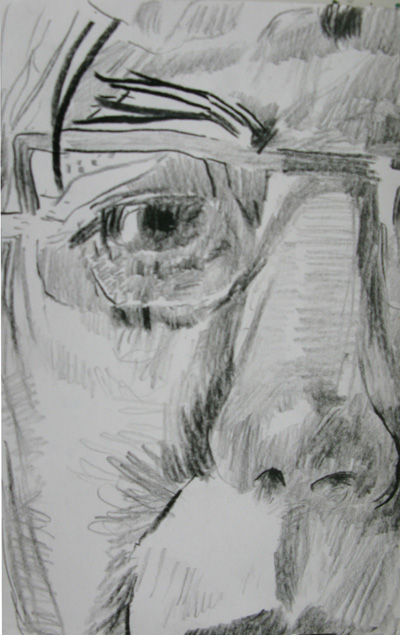
Face (sketch) by Caroline Leaf
(pencil on paper).
Courtesy of the artist. |
cl: I guess I'm attracted to organic shapes for sketching. And I like to look at surfaces closely and see how light models them. With the sketch of my face, I was looking for visible strokes as a shorthand way of modeling a face with light. The sketches start at a single point and grow outwards without composition planning.
sk: Do you miss working with the elements of time and sound?
cl: No, I don't miss the element of time. In fact I am relieved that I am not working with time. I can't imagine moving the images I'm making now, unless in a computer program, and I don't see the point of it.
But sound is something else. I used to imagine displaying my paintings with sound. Now that they are less figurative, I think less about sound.
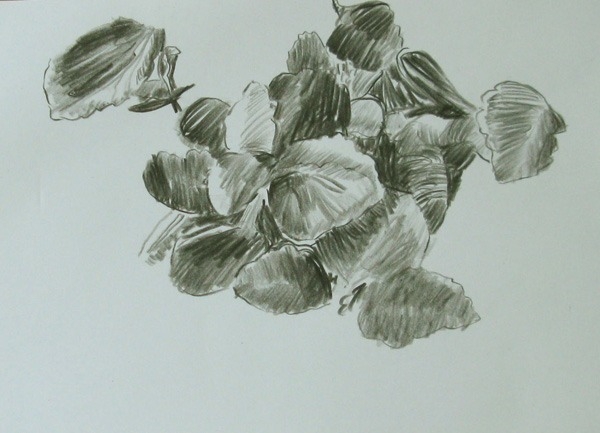
Plant (sketch) by Caroline Leaf
(pencil on paper).
Courtesy of the artist. |
Whether working in animation or paint, Caroline Leaf has a deep desire to connect with her audience. In her paintings it’s a memory, an emerging image, a moment captured or revealed through layers of colour, light, and textured strokes. In her films she reined in the temptation to improvise, her goal being to communicate a coherent story. In her paintings, she begins with improvisation and works to shape a cohesive image. Both media reveal her signature finely crafted feel and finish.
On a related note, we were very lucky in Ottawa to have the opportunity to attend a masterclass given by Caroline Leaf. If the opportunity ever comes your way, don’t hesitate to take it up. In addition to being a fascinating artist, she’s a wonderful speaker and a terrific teacher.
|
|